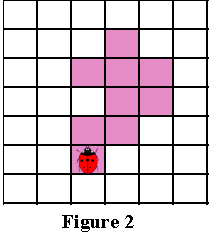
The idea behind Moore-Neighbor tracing is simple; but before we explain
it, we need to define an important concept: the Moore neighborhood
of
a pixel.
The Moore neighborhood of a pixel, P, is the set of 8 pixels
which share a vertex or edge with that pixel. These pixels are namely pixels
P1,
P2, P3, P4, P5, P6, P7 and P8 shown in Figure 1 below.
The Moore neighborhood (also known as the 8-neighbors or
indirect neighbors) is an important concept that frequently arises
in the literature.

Now we are ready to introduce the idea behind Moore-Neighbor tracing...
Given a digital pattern i.e. a group of black pixels, on a background
of white pixels i.e. a grid; locate a black pixel and declare it as your
"start" pixel. (Locating a "start" pixel can be done in a
number of ways; we'll start at the bottom left corner of the grid, scan
each column of pixels from the bottom going upwards -starting from the
leftmost column and proceeding to the right- until we encounter a black
pixel. We'll declare that pixel as our "start" pixel.)
Now, imagine that you are a bug (ladybird) standing on the start
pixel as in Figure 2 below. Without loss of generality, we
will extract the contour by going around the pattern in a clockwise direction.
(It doesn't matter which direction you choose as long as you stick with
your choice throughout the algorithm).
The general idea is: every time you hit a black pixel, P, backtrack
i.e. go back to the white pixel you were previously standing on, then,
go around pixel P in a clockwise direction, visiting each
pixel in its Moore neighborhood, until you hit a black pixel. The algorithm
terminates when the start pixel is visited for a second time.
The black pixels you walked over will be the contour of the pattern.

The following is a formal description of the Moore-Neighbor tracing algorithm:
Input: A square tessellation, T, containing a connected component P of black cells.
Output: A sequence B (b1, b2 ,..., bk) of boundary pixels i.e. the contour.
Define M(a) to be the Moore neighborhood
of pixel a.
Let p denote the current boundary pixel.
Let c denote the current pixel under consideration i.e. c
is in M(p).
Begin
The following is an animated demonstration of how Moore-Neighbor tracing
proceeds to trace the contour of a given pattern.
(We have decided to trace the contour in a clockwise direction).
The main weakness of Moore-Neighbor tracing lies in the choice of the
stopping criterion, in other words, when does the algorithm terminate?
In the original description of the algorithm used in Moore-Neigbor
tracing, the stopping criterion is visiting the start pixel for
a second time. Like in the case of the Square
Tracing algorithm, it turns out that Moore-Neighbor tracing will fail
to contour trace a large family of patterns if it were to depend on that
criterion.
What follows is an animated demonstration explaining how Moore-Neighbor
tracing fails to extract the contour of a pattern due to the bad choice
of the stopping criterion:
As you can see, improving the stopping criterion would be a good start to improving the overall performance of Moore-Neighbor tracing. There are 2 effective alternatives to the existing stopping criterion:
a) Stop after visiting the start pixel n times,
where n is at least 2, OR
b) Stop after entering the start pixel a second time
in
the same manner you entered it initially. This criterion was proposed
by Jacob
Eliosoff and we will therefore call it Jacob's
stopping criterion.
Using Jacob's stopping criterion will greatly improve the performance of
Moore-Neighbor tracing making it the best algorithm for extracting the contour
of any pattern no matter what its connectivity.
The reason for this is largely due to the fact that the algorithm checks
the whole Moore neighborhood of a boundary pixel in
order to find the next boundary pixel. Unlike the Square
Tracing algorithm, which makes either left or right turns and misses
"diagonal" pixels; Moore-Neighbor tracing will always be able to extract
the outer boundary of any connected component. The reason for that is:
for any 8-connected
(or simply connected) pattern, the next boundary pixel
lies within the Moore neighborhood of the current boundary pixel. Since
Moore-Neighbor tracing proceeds to check every pixel in the Moore neighborhood
of the current boundary pixel, it is bound to detect the next boundary
pixel.
When Moore-Neighbor tracing visits the start pixel for a second time
in the same way it did the first time around, this means that it has traced
the complete outer contour of the pattern and if not terminated,
it will trace the same contour again. This result has yet to be proved...